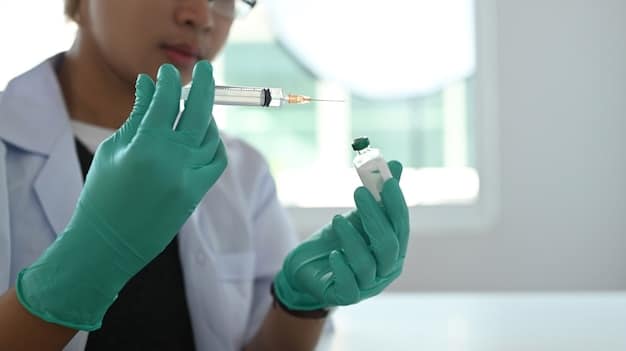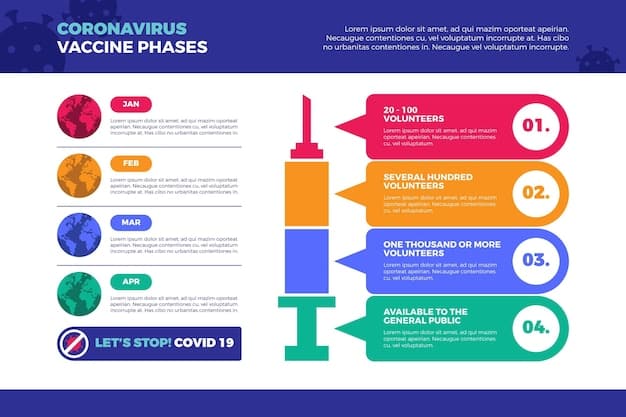Vaccination Campaigns: Public Health Initiatives Boosting Immunization Rates in the US

Vaccination campaigns, facilitated by robust public health initiatives, are significantly increasing immunization rates across the nation by improving access, promoting awareness, and addressing vaccine hesitancy, ultimately bolstering community immunity and preventing outbreaks of infectious diseases.
Vaccination campaigns: How Public Health Initiatives Are Increasing Immunization Rates Across the Nation is becoming a critical focus. These initiatives are designed to protect communities from infectious diseases by promoting and facilitating widespread immunization.
But how do these campaigns achieve their goals, and what impact are they having on public health in the U.S.? Let’s explore the multi-faceted approach of public health initiatives aimed at increasing vaccination rates and creating a healthier population.
Understanding the Importance of Vaccination Campaigns
Vaccination campaigns play a critical role in safeguarding public health. These initiatives not only protect individuals from preventable diseases but also contribute to herd immunity, which helps protect vulnerable populations who cannot be vaccinated, like infants and those with compromised immune systems.
Effective campaigns utilize various strategies to reach diverse communities, ensuring equitable access to vaccines and addressing any concerns about their safety and efficacy. Let’s dive deeper into why these campaigns are so vital.
The Role of Herd Immunity
Herd immunity occurs when a large percentage of the population is immune to a disease, making its spread unlikely. Vaccination campaigns aim to achieve this by immunizing a significant portion of the community.
Protecting Vulnerable Populations
Vaccines are especially crucial for those who are most at risk from infectious diseases, including young children, the elderly, and individuals with underlying health conditions. Vaccination campaigns prioritize these groups to minimize severe illness and complications.
- Preventing disease outbreaks through widespread vaccination.
- Reducing the severity of illness among vaccinated individuals.
- Lowering healthcare costs associated with treating preventable diseases.

By understanding the importance of vaccination campaigns, communities can work together to promote health and well-being for all. These initiatives are a cornerstone of preventative medicine, and their impact is far-reaching and long-lasting.
Key Strategies Employed in Public Health Vaccination Initiatives
Public health initiatives utilize a range of strategies to increase vaccination rates. These strategies often involve collaborative efforts between government agencies, healthcare providers, community organizations, and educational institutions.
By employing a comprehensive approach, these initiatives aim to overcome barriers to vaccination and improve public health outcomes. Let’s explore the most effective strategies in detail.
Community Outreach Programs
Community outreach programs are designed to reach individuals who may not have easy access to healthcare services. These programs often involve mobile vaccination clinics, educational workshops, and partnerships with local community leaders. Such community-based efforts are a cornerstone of successful vaccination campaigns: How Public Health Initiatives Are Increasing Immunization Rates Across the Nation.
Educational Campaigns
Educational campaigns play a vital role in addressing vaccine hesitancy. These campaigns provide accurate information about the safety and efficacy of vaccines, dispel myths, and empower individuals to make informed decisions. Effective educational campaigns leverage various communication channels, including social media, television, and printed materials.
- Increasing awareness through public service announcements.
- Providing resources and information in multiple languages.
- Engaging healthcare providers to address patient concerns.
Through the implementation of these key strategies, public health initiatives can effectively increase vaccination rates and reduce the burden of preventable diseases.

Overcoming Challenges in Vaccination Campaigns
Despite the enormous benefits of vaccination campaigns, public health officials often face several challenges that can hinder their effectiveness. These challenges include vaccine hesitancy, logistical issues, and health equity concerns. Addressing these obstacles is critical for improving the success of vaccination initiatives.
Let’s explore the most significant challenges and the strategies used to overcome them.
Combating Vaccine Hesitancy
Vaccine hesitancy, defined as the delay in acceptance or refusal of vaccines despite their availability, is a major barrier to increasing immunization rates. This hesitancy often stems from misinformation, lack of trust in healthcare providers, and concerns about side effects.
Addressing Logistical Issues
Ensuring that vaccines are readily available and accessible can be a logistical challenge, especially in rural or underserved areas. This includes maintaining the cold chain, ensuring adequate staffing, and streamlining the vaccination process. Vaccination campaigns: How Public Health Initiatives Are Increasing Immunization Rates Across the Nation require robust logistical support to reach all populations effectively.
- Partnering with pharmacies and schools to offer vaccine clinics.
- Utilizing mobile vaccination units to reach remote areas.
- Improving scheduling and appointment systems for convenience and ease of scheduling.
The Impact of Vaccination Campaigns on Public Health
The impact of vaccination campaigns: How Public Health Initiatives Are Increasing Immunization Rates Across the Nation is far-reaching and undeniable. From eradicating diseases to reducing hospitalizations, vaccinations improve public health outcomes.
When vaccines are widely administered, there is a significant reduction in the incidence of infectious diseases, as well as a decrease in the severity of illness among those who do contract such diseases.
Success Stories in Disease Eradication
One of the most notable achievements of vaccination campaigns is the eradication of smallpox. Through a global vaccination effort, this deadly disease was completely eliminated, demonstrating the transformative power of vaccines.
Reducing Hospitalizations and Healthcare Costs
Vaccination campaigns can significantly reduce hospitalizations and healthcare costs associated with preventable diseases. By preventing illness, vaccines also decrease the need for medical interventions, freeing up resources for other healthcare needs. The reduction of hospitalizations and healthcare costs is a tangible benefit from vaccination campaigns: How Public Health Initiatives Are Increasing Immunization Rates Across the Nation.
- Increased productivity among vaccinated individuals.
- Reduced absenteeism in schools and workplaces.
- Improved overall quality of life.
Future Directions and Innovations in Vaccination Campaigns
As public health continues to evolve, so too will the strategies and technologies used in vaccination campaigns. Innovations in vaccine development, delivery methods, and community engagement hold promise for further improving immunization rates and protecting public health.
Let’s explore some of the exciting advancements on the horizon.
Advancements in Vaccine Technology
Researchers are constantly working on developing new and improved vaccines that offer better protection, require fewer doses, and have fewer side effects. These advancements include mRNA vaccines, which can be developed more quickly and adapted to emerging threats. Vaccination campaigns: How Public Health Initiatives Are Increasing Immunization Rates Across the Nation are continuously enhanced by advancements in vaccine technology.
Improving Vaccine Delivery Methods
Innovations in vaccine delivery methods are making it easier to administer vaccines in a variety of settings. This includes needle-free injectors, which can reduce pain and anxiety, and self-administered vaccines, which can improve access in remote areas. Such strategies promote widespread use of Vaccination campaigns: How Public Health Initiatives Are Increasing Immunization Rates Across the Nation.
- Personalized vaccination schedules based on individual risk factors.
- Integration of vaccination records into electronic health records.
- Use of artificial intelligence to predict and prevent outbreaks.
The Role of Policy and Funding in Supporting Vaccination Campaigns
Effective vaccination campaigns require strong policy support and adequate funding. Government policies can mandate or incentivize vaccination, while funding can ensure that vaccines are available to all who need them, regardless of their ability to pay.
Let’s examine the critical role of policy and funding in sustaining successful vaccination efforts.
Government Policies and Mandates
Government policies and mandates can play a crucial role in increasing vaccination rates. These policies may include school immunization requirements, workplace vaccination policies, and incentives for healthcare providers to promote vaccination. Such mandates are critical to the success of vaccination campaigns: How Public Health Initiatives Are Increasing Immunization Rates Across the Nation.
Ensuring Equitable Access through Funding
Funding is essential for ensuring that vaccines are available to all, regardless of their socioeconomic status. This includes government funding for vaccine purchases, subsidies for healthcare providers, and programs to support community outreach efforts.
- Increased allocation of resources for vaccination infrastructure.
- Strengthening partnerships between government, healthcare providers, and community organizations.
- Long-term investment in research and development of new vaccines.
| Key Point | Brief Description |
|---|---|
| 🛡️ Herd Immunity | Protecting the community by immunizing a large percentage of the population. |
| 📢 Education | Dispelling myths and providing accurate information about vaccine safety. |
| 🏥 Accessibility | Ensuring vaccines are readily available, especially in underserved areas. |
| 💰 Funding | Securing financial resources for vaccine purchases and community outreach. |
Frequently Asked Questions
The primary goals of vaccination campaigns: How Public Health Initiatives Are Increasing Immunization Rates Across the Nation include preventing disease outbreaks, reducing the severity of infections, and achieving herd immunity to protect vulnerable populations.
Public health initiatives combat vaccine hesitancy through educational campaigns, community outreach, and partnerships with trusted healthcare providers to provide accurate vaccine information and address safety concerns.
Government policies, like school immunization requirements and workplace vaccination policies, significantly increase vaccination rates, ensuring widespread protection against preventable diseases, and supporting comprehensive vaccination campaigns: How Public Health Initiatives Are Increasing Immunization Rates Across the Nation.
Mobile vaccination campaigns bring vaccines directly to underserved and remote communities, breaking down geographical barriers and increasing vaccine uptake among vulnerable populations, thus expanding the reach of vaccination campaigns: How Public Health Initiatives Are Increasing Immunization Rates Across the Nation.
Advancements like needle-free injectors and self-administered vaccines are improving vaccine delivery by reducing pain, anxiety, and logistical challenges, thereby increasing the efficiency and accessibility of the nation’s vaccination campaigns.
Conclusion
Vaccination campaigns: How Public Health Initiatives Are Increasing Immunization Rates Across the Nation play a vital role in safeguarding public health. By implementing diverse strategies, addressing vaccine hesitancy, and fostering strong policy support, these initiatives have demonstrably reduced the burden of preventable diseases.
As technology and public health practices evolve, it is essential to continue investing in and refining vaccination campaigns to ensure a healthier future for all communities.





